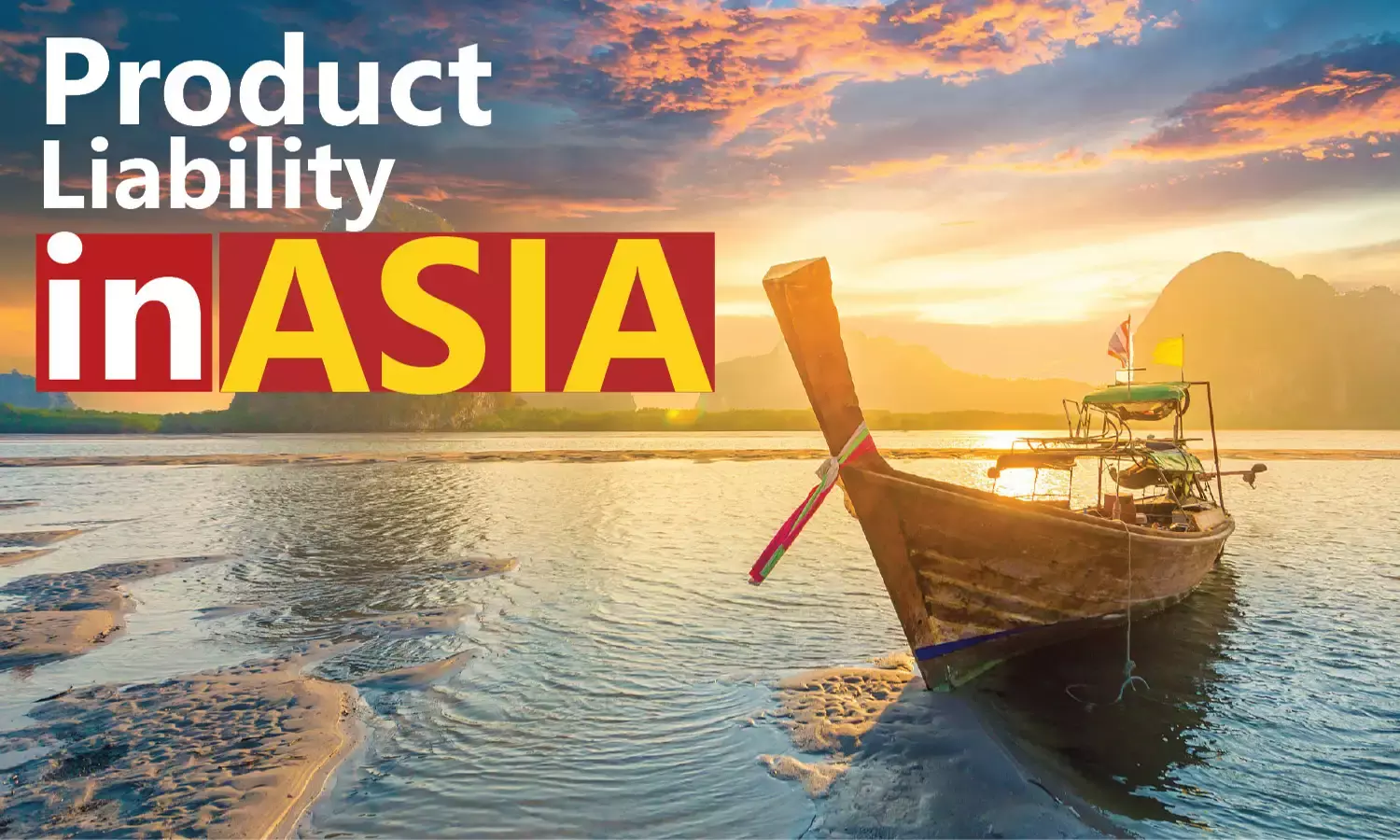Product Liability in Asia
Given the development of ASEAN as a potential trading bloc, it is hoped that product liability laws, or indeed consumer protection legislation;

Product Liability in Asia Given the development of ASEAN as a potential trading bloc, it is hoped that product liability laws, or indeed consumer protection legislation that address product liability, be promulgated in consultation with each other such that the same basic principles of product liability and the protection of the consumer be consistent The world is becoming...
Product Liability in Asia
Given the development of ASEAN as a potential trading bloc, it is hoped that product liability laws, or indeed consumer protection legislation that address product liability, be promulgated in consultation with each other such that the same basic principles of product liability and the protection of the consumer be consistent
The world is becoming increasingly connected. Consequently, with increasing globalization, product liability development in one part of the world will have ramifications globally. It is imperative that countries remain cognizant of other developments in the product liability space.
DEVELOPMENT
In Asia generally, the driving force behind the development of product liability law is the increasing awareness of consumer rights propelled by economic development and the realization by governmental bodies of the need to protect consumers against product manufacturers. However, the different pace of economic development within Asia makes it practically impossible to expect homogeneity in the region. For example, in many Asian countries there is no specific product liability legislation, but generally subsume such protection under the principles of common law or general consumer protection legislation. On the other hand, there are a substantial number of jurisdictions that have not enacted specific product liability laws. For example, there is no general statutory provision regulating the sale of defective products in Hong Kong despite recommendations being made in the Law Reform Commissioner Paper on Civil Liability for Unsafe Products (issued in 1998).
One of the key inspirations behind product liability legislation is the European Community's Product Liability Directive ("EC Directive"). The central tenor of the EC Directive was the introduction of the strict liability regime for defective products. With increasing economic development, given that manufacturers have greater resources to anticipate, prevent, and investigate product defects than consumers, the introduction of the strict liability regime was inevitable. It was previously thought that the strict liability regime conferred better protection on victims and increased the safety standards of products.
Countries such as Japan, India, China and Korea have identified with the underlying rationale of the EC Directive and thus followed suit. Brief summaries of the Product Liability landscape of the aforesaid countries are set out below:
a) Japan's Product Liability Law ("PL Law"), which was enacted in 1994, imposes strict liability on defendants for death, injury, and damage caused by a defective product manufactured, processed, imported, or represented as such by the defendant. A series of cases resulting from defective food or drugs was also the leading reason for introducing a new legislation regulating product liability and consumer safety. Japan has even taken it further to introduce a positive duty on suppliers of any consumer goods to notify the government of any serious product-related accident by way of an amendment in 2006 to the Consumer Product Safety Law.
b) The Bhopal disaster in India, considered as the worst industrial disaster in the world, drew India's attention (and indeed the rest of the ASEAN region) to the need to examine and reform law relating to liability for unsafe productions and production processes. The increasing realization of helplessness of the consumers caused the enactment of Consumer Protection Act of India in 1986 and now the newly enacted strict liability regime in India.
c) The People's Republic of China ("PRC") adopted consumer rights' protection legislation in 1993 under the Law of the People's Republic of China on Product Liability. It created statutory liability for the producer and seller.
d) In Korea, the Consumer Standard Act was enacted in 2006 and was amended many times thereon. It regulates manufacturing safety, and provides for provisions regarding consumer rights, obligations of manufacturers and retailers, as well as the role of the government in regulating consumer protection. The Korean Government also has policies facilitating product recalls with a set of guidelines instituting voluntary and mandatory product recalls.
On the other hand, there are a substantial number of jurisdictions that have not enacted specific product liability laws. For example, there is no general statutory provision regulating the sale of defective products in Hong Kong despite recommendations being made in the Law Reform Commissioner Paper on Civil Liability for Unsafe Products (issued in 1998). Nor is there statutory enactment in Singapore that creates a comprehensive regime for product liability, though there are specific statutes that govern particular areas of law where product liability issues may arise. Like Hong Kong, product liability in Singapore is largely based on common law. This is supplemented by the creation of various organizations such as the Hong Kong Consumer Council or the Consumers Association of Singapore ("CASE"). Both provide a complaint system in which they may try and mediate between the parties, but do not have any judicial or quasi-judicial powers. In the event that mediation is not successful, the only recourse is to make a claim through the court system.
EFFICACY OF LEGISLATION/CONSUMER PROTECTION
The enactment of specific product liability legislation is not a one-stop solution to addressing all product liability-related issues. Effective protection still hinges on other factors such as the ease of enforcement of such legislation, easy consumer access to the justice system and the integrity of such systems.
Effective product liability protection is especially challenging in the developing Asian countries where the level of awareness and the financial means of the general populace to obtain redress may not be as high as that of the developed world. This is further compounded by the lack of sophistication of the legal systems (such as under-developed court systems and out-dated legislation) and the inadequate availability of resources to enforce any such laws.
As a compromise, in view of the limited resources (especially in developing Asian countries), some Asian countries such as India and Sri Lanka have set up special consumer tribunals to assist in the progression of product liability protection. Compared to formal litigation, consumer tribunals are preferred as there is speedy and affordable disposal of cases. Its flexibility may cater especially well to developing countries, particularly due to a low-entry initiation mode, a simple but rights-based dispute resolution procedure and a quick enforcement of the outcome. Unfortunately, the efficacy of these tribunals have turned out to be different from what the drafters had hoped. Each matter is bounced around within the processes and hearings (whether substantive or procedural), and decisions or rulings are made after significant delay. Often there are avenues of appeal to the courts, which in turn causes significant delay and costs. For example, in India, the definition of what constitutes a "consumer" under the Consumer Protection Act 1986 ("CPA") is still uncertain, with two appeals to the Supreme Court of India (that we are aware of) dealing specifically on this issue. Consequently, the Commissions are set up under the CPA to adjudicate consumer claims.
On the other hand, the threat of the immense damages compensation resulting from class actions may propel the speed of development of the product liability regime in Asia. The attraction of class action claims is that it enhances access to justice through the provision of a remedy to those who have little financial means to seek judicial redress. Class actions and punitive damages are gaining traction in Asia. Jurisdictions such as Thailand (2015) and Indonesia (2012) have promulgated laws and/or regulations recognizing class actions. In 2016, Japan also joined the bandwagon and introduced a "Japanese-style" class action regime. South Korea is about to pass legislation which would significantly expand the scope of its existing class action law (which is only available for securities-related cases) and allow the award of punitive damages. As for China, it first introduced punitive damages for defective products in its Tort Responsibility Law in 2010 and on 31 July 2020, its Supreme Court released the Provisions on Issues of Representative Securities Litigation (effective immediately) which provides for class action claims for investors securities-related matters. As for Hong Kong, it remains stuck with a report published by the Law Reform Commission of Hong Kong proposing that a class action regime be introduced in Hong Kong. The reform is more of an opt-out model that would permit product liability and personal injury claims, but it rejected the adoption of contingency fees or punitive damages and urged the preservation of the "loser pays rule". The Consumer Protection Act in India also allows the filing of class action suits by any trade or registered consumer association, any Central or State Government, or a number of consumers where there is a common interest. It is of particular interest that Singapore, with its highly developed economy and legal system, has not seen the need for a class action regime and it remains to be seen whether it will embrace such an action. In that regard, it is our view that class actions will become a socially accepted normality in the foreseeable future given the increasing awareness of consumers of their legal rights coupled with greater access to information. In short, product liability on a global scale presents new challenges for multinational manufacturers.
INSURANCE
Another factor that affects the development of product liability is insurance claims. Insurers are generally the first point of contact when a product liability claim is made. The globalization of the product supply has invariably contributed to the rise of global insurance claims. As such, the principles behind insurers' rights of subrogation are generally well understood. Insurers who indemnify an insured for a loss thereby become entitled to claim against the wrong-doer who has caused that loss, i.e. by paying a claim the insurer "steps into the shoes "of the insured and takes over any rights it has against the third parties who may be responsible for the loss. It is an equitable principle that prevents the insured from retaining the benefit of a double recovery. Generally, in the automobile sector, a customer may be more inclined to make an insurance claim for any loss or damage resulting from any defect in the vehicle. Thereafter, it is up to the insurance company to proceed with a subrogation claim against the manufacturer or reporter. Again, in this regard, we see different trends in different parts of the Asia-Pacific region. We have observed that in jurisdictions such as Japan, Korea and Taiwan, insurance companies have been more proactive in seeking compensation against the manufacturer and/or importer of the products. However, as we move southward, the number of subrogation claims has significantly reduced. This is an interesting phenomenon, especially in countries with more developed legal systems such as Singapore or Malaysia where we might expect insurance companies to use subrogation to recoup the pay-outs if there is good cause to do so. If defective products are simply covered by insurance, there is less pressure on the manufacturers to ensure that they continue to place emphasis on the safety of their products.
CONCLUSION
Despite the non-homogeneity of the levels of development within Asia, the development of a product liability regime is inevitable. It is unmistakable that legislators and courts in Asia are becoming increasingly sophisticated. Naturally, this will result in a gradual push towards more stringent regulation and establishment of enforcement mechanisms to better protect consumers and reduce the instances of safety scandals. Given the development of ASEAN as a potential trading bloc, it is hoped that product liability laws, or indeed consumer protection legislation that address product liability, be promulgated in consultation with each other such that the same basic principles of product liability and the protection of the consumer be consistent. In that regard, it may itself form a model that takes into account the cultural and political diversity in the region. This could very well cause other countries in the Asia-Pacific to look carefully at such legislation for use in their own jurisdictions. If this can be achieved, other non-ASEAN members in the region might be interested in either following the model or taking parts of it that would be usefulBy: in their country.
Disclaimer – The views expressed in this article are the personal views of the authors and are purely informative in nature.



